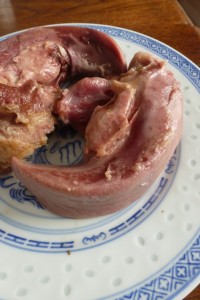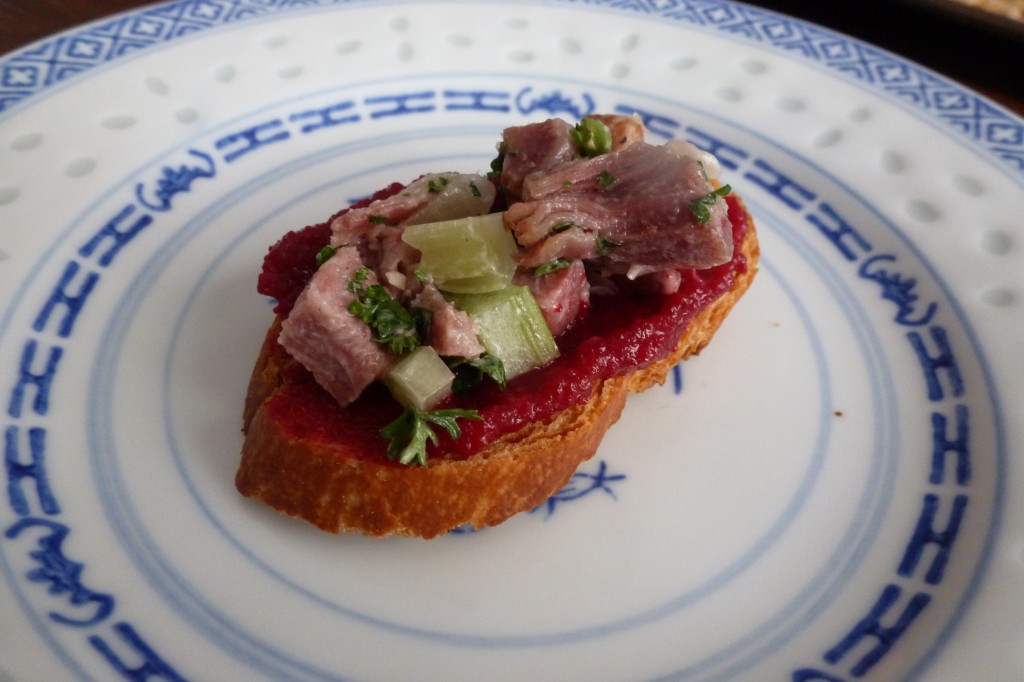 The tongue is one of those cuts that sounds way, way weirder than it really is.
The tongue is one of those cuts that sounds way, way weirder than it really is.
The tongue has two sections. There’s the part that we usually think of when we consider an animal’s tongue: the part at the front that can move freely around the mouth. Then there’s the base, at the back of the mouth. The meat from these two sections is different.
The tip meat has a very close, dense texture, and is lean. The base meat has a coarser texture, and is a bit fatty.
The meat from both sections is very tough in its raw state. As you can imagine, the tongue is a highly exercised muscle, and requires extensive cooking at low temperatures, usually using a moist-heat method. “Boiled tongue” is a classic, though I prefer braising for reasons I’ll discuss below.
Finding Tongue. When you buy a side of pork, there is not typically half a tongue on the carcass; the tongue is removed whole before the pig is split down the middle. This is good, because it means we have whole pork tongues to work with, but it also means that if you’re ordering a side of pork, or a split head, you’ll have to expressly ask that the tongue be included.
If you want only a tongue, most pork producers will have no problem providing you one. They usually sell for a few bucks.
Curing Tongue. Once you’ve secured a tongue, you’ll have to ask yourself if you want to cure it. I would say that if you plan on incorporating tongue into a ragout, or grind for sausage, or some other preparation that is going to mask its tonguiness, don’t cure it. If you’re going to be enjoying it sliced or chopped on its own, cure it.
I use the Basic Curing Brine for four days.
Cooking Tongue. The classic method of preparation, especially for beef tongue, is boiling. This does a fine job of tenderizing the meat, but I figure if you’ve gone to the trouble of curing a tongue so that it’s seasoned throughout, there’s no sense in boiling it unless you plan on consuming the cooking liquid as a broth. As we’ve noted on Button Soup several times (eg. cured bath chaps, ham hocks, et c), simmering cured meat in an excess of water leaches the salt and flavours from the meat into the liquid and makes the meat very, very bland.
I suppose the ideal solution is to vacuum-seal the tongue and poach it gently. I don’t have a vacuum sealer, but I’ve found that a shallow braise is just as effective at tenderizing the meat and doesn’t leach much cure from the flesh. I add enough light pork stock to come maybe a third up the side of the tongues. If you don’t have pork stock on hand, use water and vegetables, and by the end of cooking you’ll have some. If you are using a pressure cooker, be sure that you add enough stock to meet the minimum liquid requirements.
Bring the liquid to a boil, then cover the pot, reduce the heat to low, and simmer until the meat is tender, maybe three hours. One hour in a pressure cooker.
Peeling Tongue. There is a layer of “skin” on the tongue. It’s not like skin from other parts of the animal, which is thick, and has a layer of fat beneath. This is very thin. It’s not inedible or unsafe to eat, but it is always peeled away and discarded. If the meat has been cooked, the skin should come away easily. Best done while the tongue is still warm.
Eating Tongue. Now that you have a cured, cooked, peeled pig’s tongue, the world is yours. You can slice it cold and eat it with a bit of vinegar. Maybe put it on a sandwich.
Church Function Food. I’ve been thinking a bit about “church function food” lately. I remember certain events in church basements, things like bake sales, or the reception after a funeral. A very specific kind of food was served there. From my own childhood in Ontario I remember there was a lot of mayonnaise: creamy slaw, macaroni salad, and potato salad, for instance. For sweets there was jello, date squares, brownies, and cakes with ridiculous names like Queen Elizabeth and Wartime. I really didn’t mind this food.
My favourite church function dish is minced ham sandwiches: ground ham bound with mayonnaise and garnished with finely chopped celery and parsley, served between slices of white bread, possibly crustless. It’s the whitest dish known to man.
Here’s a variation on that. Tongue on toast. Chop the pork tongue, mix with celery and parsley. Here it’s taken with beet ketchup.
